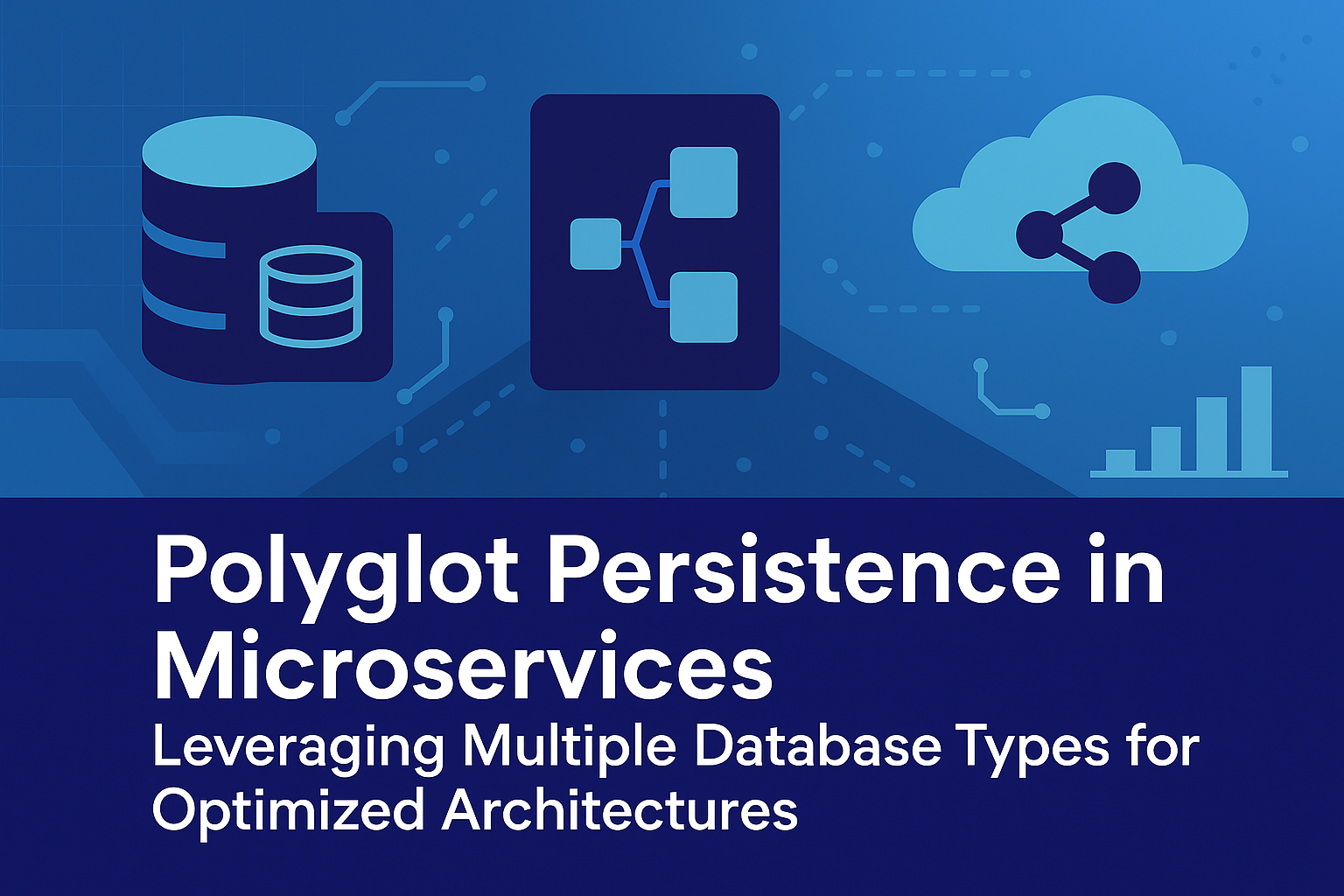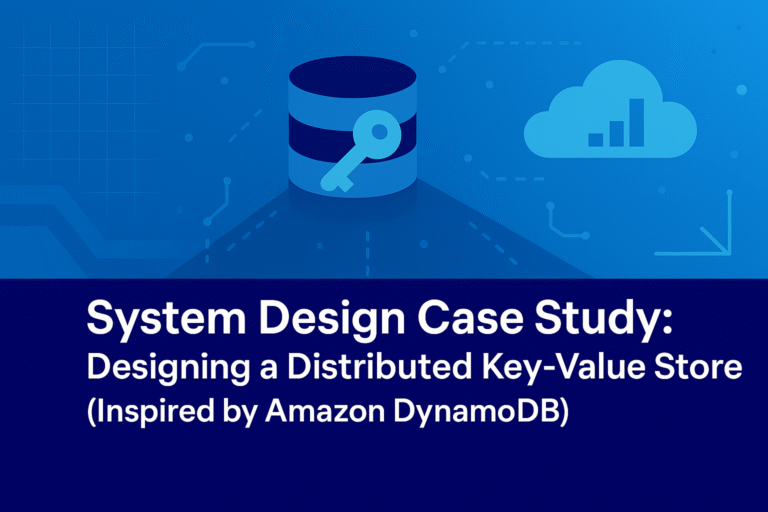Concept Explanation
Polyglot persistence refers to the architectural practice of using multiple database types within a single application, particularly in microservices architectures, to leverage the strengths of different databases for specific data storage and access patterns. In microservices, where each service is independently deployable and manages its own data, polyglot persistence allows developers to select the most suitable database for each service’s requirements, enhancing performance, scalability, and flexibility. Unlike traditional monolithic applications that often rely on a single relational database, polyglot persistence embraces a variety of database types—such as relational, key-value, document, column-family, graph, time-series, in-memory, and search engine databases—to address diverse use cases like transactional processing, analytics, caching, or search. This comprehensive analysis explores the mechanisms, applications, advantages, limitations, real-world examples, implementation considerations, and trade-offs of polyglot persistence in microservices, providing technical depth and practical insights for system design professionals.
Mechanisms of Polyglot Persistence in Microservices
Polyglot persistence in microservices involves selecting and integrating multiple database types to align with each microservice’s specific workload. The key mechanisms include:
- Service-Specific Database Selection: Each microservice chooses a database type based on its data model and access patterns (e.g., relational for structured data, key-value for fast lookups, document for flexible schemas).
- Decentralized Data Ownership: Microservices own their data, with no shared databases across services, adhering to the microservices principle of loose coupling.
- Data Access Patterns:
- Commands: Write operations (e.g., CREATE, UPDATE) handled by the service’s database.
- Queries: Read operations optimized for specific patterns (e.g., full-text search, range queries).
- Inter-Service Communication: Services communicate via APIs (e.g., REST, gRPC) or event-driven mechanisms (e.g., Kafka) to share data, avoiding direct database access.
- Data Synchronization: Event sourcing or message queues (e.g., Kafka, RabbitMQ) propagate data changes across services to maintain consistency.
- Schema Flexibility: Each service defines its schema, tailored to its database type (e.g., JSON in MongoDB, key-value pairs in Redis).
These mechanisms enable microservices to operate independently while leveraging specialized databases for optimal performance.
Applications Across Database Types
Polyglot persistence is applied across various database types to support diverse microservices workloads, including the 15 database types referenced in prior discussions:
- Relational Databases (RDBMS): PostgreSQL, MySQL for structured, transactional data (e.g., order processing).
- Key-Value Stores: Redis, DynamoDB for high-speed lookups and caching (e.g., session management).
- Document Stores: MongoDB, CouchDB for semi-structured, flexible data (e.g., user profiles).
- Column-Family Stores: Cassandra, HBase for wide-column, write-heavy data (e.g., event logs).
- Graph Databases: Neo4j for relationship-heavy data (e.g., social networks).
- Time-Series Databases: InfluxDB, TimescaleDB for temporal data (e.g., metrics).
- In-Memory Databases: Redis, Memcached for low-latency caching (e.g., leaderboard scores).
- Wide-Column Stores: Bigtable for scalable analytics (e.g., user activity).
- Object-Oriented Databases: ObjectDB for object persistence (e.g., application state).
- Hierarchical Databases: IBM IMS for legacy tree structures (e.g., organizational data).
- Network Databases: OrientDB for complex relationships (e.g., network topology).
- Spatial Databases: PostGIS for geospatial data (e.g., location services).
- Search Engine Databases: Elasticsearch, Solr for full-text search (e.g., product search).
- Ledger Databases: Amazon QLDB for immutable logs (e.g., financial transactions).
- Multi-Model Databases: ArangoDB for hybrid workloads (e.g., key-value and graph).
Each microservice selects a database type aligned with its needs, such as PostgreSQL for transactional consistency, Redis for caching, or Elasticsearch for search.
Advantages of Polyglot Persistence
- Optimized Performance: Each database is chosen for its strength (e.g., Redis for < 1ms lookups, Elasticsearch for < 10ms search).
- Scalability: Services scale independently with their databases (e.g., add Redis nodes for caching, Cassandra nodes for logs).
- Flexibility: Supports diverse data models (e.g., JSON in MongoDB, graphs in Neo4j).
- Resilience: Decentralized data reduces single points of failure, ensuring 99.99% uptime.
- Tailored Consistency: Choose strong consistency (RDBMS) or eventual consistency (NoSQL) per service.
Limitations of Polyglot Persistence
- Increased Complexity: Managing multiple databases requires expertise in each (e.g., SQL for PostgreSQL, CQL for Cassandra).
- Data Consistency Challenges: Eventual consistency across services may cause delays (e.g., 100ms sync lag).
- Operational Overhead: Monitoring, backup, and scaling for multiple databases increase costs (e.g., 20% more DevOps effort).
- Integration Complexity: Inter-service data sharing via APIs or events adds latency and complexity (e.g., 10ms API calls).
- Skill Requirements: Teams need proficiency in diverse database technologies, increasing training costs.
Real-World Example: Netflix’s Microservices Architecture
- Context: Netflix processes 1B user interactions/day, requiring diverse data handling for streaming, recommendations, and billing.
- Polyglot Persistence Usage:
- Cassandra: Stores user viewing history (write-heavy, 100,000 writes/s, < 5ms latency).
- Elasticsearch: Powers content search (10M queries/day, < 10ms latency).
- MySQL: Manages billing transactions (1M transactions/day, ACID compliance).
- Redis: Caches user sessions (< 1ms latency, 90% cache hits).
- Neo4j: Handles recommendation graphs (100,000 req/s, < 5ms latency).
- Implementation: Services communicate via Kafka for event-driven updates (e.g., UserWatchedVideo event updates recommendation model). Each service owns its database, with APIs (gRPC) for cross-service queries.
- Performance: Achieves 99.99% uptime, handling 100M users with minimal latency.
- Monitoring: Uses Prometheus/Grafana for database metrics (e.g., Cassandra write latency, Redis cache hits).
Implementation Considerations
- Database Selection:
- Match database to workload: PostgreSQL for transactions, MongoDB for flexible schemas, Redis for caching, Elasticsearch for search.
- Example: Use Cassandra for logs, Neo4j for social graphs.
- Deployment:
- Use managed services (AWS RDS for MySQL, DynamoDB for key-value, Elastic Cloud for Elasticsearch) with 16GB RAM nodes.
- Deploy on Kubernetes for self-hosted databases (e.g., Cassandra, MongoDB).
- Data Synchronization:
- Use Kafka or RabbitMQ for event-driven updates (e.g., publish OrderCreated to update inventory service).
- Implement CQRS with event sourcing for consistency (e.g., store events in Kafka, read models in PostgreSQL).
- Performance Optimization:
- Cache frequent queries in Redis (TTL 300s).
- Optimize sharding (e.g., hash-based in Cassandra, range-based in PostgreSQL).
- Monitoring:
- Track latency (< 5ms for reads, < 1ms for cache), throughput (100,000 req/s), and sync lag with Prometheus/Grafana.
- Monitor database-specific metrics (e.g., Cassandra nodetool cfstats, Redis INFO).
- Security:
- Encrypt data with AES-256, use TLS 1.3 for communication.
- Implement RBAC for database access (e.g., PostgreSQL roles, MongoDB users).
- Testing:
- Stress-test with YCSB for 1M req/s across databases.
- Simulate failures with Chaos Monkey to validate resilience.
Trade-Offs and Strategic Considerations
These align with prior discussions on database trade-offs:
- Performance vs. Complexity:
- Trade-Off: Polyglot persistence optimizes performance (e.g., < 1ms for Redis lookups) but increases system complexity (multiple databases).
- Decision: Use for high-scale microservices (e.g., Netflix), simpler databases for small apps.
- Interview Strategy: Justify polyglot for diverse workloads, single database for simplicity.
- Consistency vs. Availability:
- Trade-Off: Relational databases (MySQL) offer strong consistency but limited scalability. NoSQL (Cassandra) provides availability but eventual consistency (100ms lag).
- Decision: Use RDBMS for transactions, NoSQL for analytics/caching.
- Interview Strategy: Propose strong consistency for billing, eventual for logs.
- Scalability vs. Operational Overhead:
- Trade-Off: Polyglot scales services independently but increases DevOps effort (e.g., 20% more monitoring).
- Decision: Use managed services (AWS, Google Cloud) to reduce overhead.
- Interview Strategy: Highlight managed databases for operational simplicity.
- Flexibility vs. Integration:
- Trade-Off: Diverse databases support varied schemas but require complex integration (e.g., Kafka for sync).
- Decision: Use event-driven sync for loose coupling, APIs for direct access.
- Interview Strategy: Propose Kafka for scalability, REST for simplicity.
- Cost vs. Performance:
- Trade-Off: Managed databases (e.g., DynamoDB $0.25/GB/month) improve performance but raise costs compared to self-hosted (e.g., Cassandra $0.10/GB/month).
- Decision: Use managed for enterprise, self-hosted for startups.
- Interview Strategy: Balance cost with performance requirements.
Additional Real-World Examples
- Uber (Ride-Sharing Platform):
- Context: Handles 1M ride requests/day, needing geospatial, logging, and transactional data.
- Usage: PostGIS for geolocation (R-Tree indexes), Cassandra for ride logs (LSM Trees), MySQL for payments (B-Trees).
- Impact: Achieves < 5ms latency for location queries, 99.99% uptime with Kafka-based event sync.
- Amazon (E-Commerce Platform):
- Context: Processes 10M product searches/day, requiring fast search and order processing.
- Usage: Elasticsearch for search (Inverted Indexes), DynamoDB for cart (Hash Tables), Aurora for orders (B+ Trees).
- Impact: Supports 100,000 req/s with < 10ms latency, using SQS for inter-service communication.
- Twitter (Social Media):
- Context: Manages 500M tweets/day, needing caching and analytics.
- Usage: Redis for caching (Hash Tables), Bigtable for analytics (Bitmaps), Neo4j for follower graphs.
- Impact: Ensures < 1ms cache latency, 99.99% uptime with Kafka sync.
Discussing in System Design Interviews
- Clarify Requirements:
- Ask: “What are the data access patterns (transactions, search, caching)? What’s the scale (1M or 1B req/day)? Is consistency or latency critical?”
- Example: For e-commerce, confirm 1M orders/day, search-heavy, and caching needs.
- Propose Databases:
- Relational: “Use PostgreSQL for orders with ACID compliance.”
- Key-Value: “Use Redis for session caching with < 1ms latency.”
- Document: “Use MongoDB for product catalogs with flexible schemas.”
- Search: “Use Elasticsearch for product search with < 10ms latency.”
- Example: “For Amazon, PostgreSQL for transactions, Elasticsearch for search, Redis for carts.”
- Address Trade-Offs:
- Explain: “Polyglot optimizes performance but adds complexity. PostgreSQL ensures consistency, Redis reduces latency.”
- Example: “For Uber, PostGIS for geospatial, Cassandra for logs.”
- Optimize and Monitor:
- Propose: “Cache in Redis, shard Cassandra by user_id, monitor with Prometheus.”
- Example: “Track Redis cache hits, Cassandra write latency.”
- Handle Edge Cases:
- Discuss: “Handle consistency with event sourcing, mitigate failures with retries.”
- Example: “For Twitter, use Kafka to sync tweet analytics.”
- Iterate Based on Feedback:
- Adapt: “If latency is critical, prioritize Redis over MongoDB.”
- Example: “For search, switch to Solr if Elasticsearch costs are high.”
Integration with Prior Data Structures
Polyglot persistence leverages data structures discussed previously:
- B-Trees/B+ Trees: Used in RDBMS (PostgreSQL, MySQL) for indexing orders.
- Hash Tables: Used in Redis, DynamoDB for caching sessions.
- LSM Trees: Used in Cassandra for logging events.
- Bloom Filters: Optimize Cassandra reads in logging services.
- Tries: Used in Elasticsearch for autocomplete.
- Skip Lists: Used in Redis for leaderboards.
- Bitmaps: Used in Bigtable for analytics.
- R-Trees: Used in PostGIS for geospatial queries.
- Inverted Indexes: Used in Elasticsearch for search.
Conclusion
Polyglot persistence in microservices enables optimized data management by selecting the best database for each service’s needs, leveraging relational, NoSQL, and specialized databases. It supports diverse workloads—transactions, caching, search, and analytics—with examples from Netflix, Uber, Amazon, and Twitter demonstrating its impact. Trade-offs like complexity, consistency, and cost guide strategic choices, while careful implementation ensures scalability and resilience.




